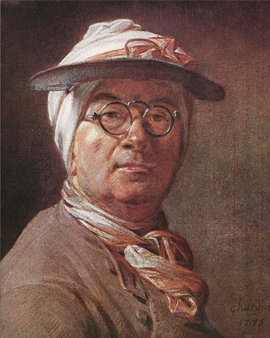On a dark day in November 1699 he saw the light of day in Paris: Jean Siméon Chardin. Born as the oldest son of a master carpenter in the artists' quarter of Saint-Germain-des-Prés, he was later to take over his father's business. Accordingly, he received training as a craftsman. But only a little later his true vocation, his talent for painting, became apparent. His father, who was not unaware of this, sent him to Pierre Jacques Cazes when he was 19. But the methods Chardin used to teach in his studio were more than meagre. He had to copy nothing but stitches!
The young man decided to continue his apprenticeship with Noel-Nicolas-Coypel because he hoped to learn more there. It was through him that Chardin's interest in still lifes was finally awakened. Nevertheless, he remained true to himself and did not limit himself to the style of the time. Rather, his works were characterized by a special individualism that expressed itself through clarity and modesty. The perfection of his compositions was most important to him, even more so than the themes themselves. Hardly any other painter was able to breathe so much life into his paintings. He also never had to travel around to find inspiration in distant countries.
Chardin achieved great fame with his genre paintings and still lifes, in which he mainly used the French bourgeoisie as a basis. His pictures, completed to the highest perfection, radiate concentration and calm that is second to none. Moreover, a few years later he was admitted to the Parisian Academy as a so-called animal and fruit painter and became a member of the Luke Guild.
In 1731 Chardin could finally marry Marguerite Saintard, whom he had already met in 1724. Due to Chardin's poor financial situation, the wedding had been postponed years before. But even now, the two of them were deprived of a sumptuous dowry. Instead, Chardin had to look for another source of income, which he found with Jean-Baptiste van Loo, a French rococo painter. For him, Chardin had to restore works by Francesco Primaticcio. In 1735, however, Chardin's wife died, with whom he had two children (Jean-Pierre and Maguerite-Agnès).
Before Jean Siméon Chardin suffered from biliary problems and his eyesight deteriorated at an advanced age, his financial situation had changed radically. Both the bourgeoisie and King Louis XV were now among his clients, and his marriage to Marguerite Pouget further improved his situation. He was able to move into an apartment in the Louvre and received a fixed pension from the King. He also became treasurer of the Academy.
Because of his health problems he now began to paint in pastels. Nevertheless the orders became fewer, his opponents increasingly took over his duties and his salary shrank. Finally, in 1779 Chardin was almost blind and died in Paris.
×





.jpg)
.jpg)
.jpg)
.jpg)
.jpg)
.jpg)
.jpg)
.jpg)
.jpg)
.jpg)
.jpg)
.jpg)
.jpg)
.jpg)
.jpg)
.jpg)
.jpg)
.jpg)
.jpg)
.jpg)
.jpg)
.jpg)
.jpg)
.jpg)
.jpg)
.jpg)
.jpg)
.jpg)
.jpg)
.jpg)
.jpg)
.jpg)
.jpg)
.jpg)
.jpg)
.jpg)
.jpg)
.jpg)
.jpg)
.jpg)
.jpg)
.jpg)
.jpg)
.jpg)
_-_(MeisterDrucke-999052).jpg)
_-_(MeisterDrucke-999052).jpg)
.jpg)
.jpg)
.jpg)
.jpg)
_-_(MeisterDrucke-1662143).jpg)
_-_(MeisterDrucke-1662143).jpg)
_-_(MeisterDrucke-1662208).jpg)
_-_(MeisterDrucke-1662208).jpg)
_-_(MeisterDrucke-1662203).jpg)
_-_(MeisterDrucke-1662203).jpg)
_-_(MeisterDrucke-1662201).jpg)
_-_(MeisterDrucke-1662201).jpg)
_-_(MeisterDrucke-1662202).jpg)
_-_(MeisterDrucke-1662202).jpg)
.jpg)
.jpg)
.jpg)
.jpg)
_-_(MeisterDrucke-1662218).jpg)
_-_(MeisterDrucke-1662218).jpg)
.jpg)
.jpg)
.jpg)
.jpg)
_-_(MeisterDrucke-1663569).jpg)
_-_(MeisterDrucke-1663569).jpg)
.jpg)
.jpg)
_-_(MeisterDrucke-1663266).jpg)
_-_(MeisterDrucke-1663266).jpg)
.jpg)
.jpg)
.jpg)
.jpg)
.jpg)
.jpg)
.jpg)
.jpg)
.jpg)
.jpg)
_-_(MeisterDrucke-1663224).jpg)
_-_(MeisterDrucke-1663224).jpg)
.jpg)
.jpg)
.jpg)
.jpg)
.jpg)
.jpg)
 - (MeisterDrucke-112389).jpg)
 - (MeisterDrucke-112389).jpg)
.jpg)
.jpg)
.jpg)
.jpg)
.jpg)
.jpg)
.jpg)
.jpg)
_-_(MeisterDrucke-1663584).jpg)
_-_(MeisterDrucke-1663584).jpg)
.jpg)
.jpg)
.jpg)
.jpg)
.jpg)
.jpg)
.jpg)
.jpg)
_-_oil_on_canvas_-_(MeisterDrucke-972350).jpg)
_-_oil_on_canvas_-_(MeisterDrucke-972350).jpg)
_-_(MeisterDrucke-1663689).jpg)
_-_(MeisterDrucke-1663689).jpg)
.jpg)
.jpg)
_-_(MeisterDrucke-1662211).jpg)
_-_(MeisterDrucke-1662211).jpg)
_-_(MeisterDrucke-946833).jpg)
_-_(MeisterDrucke-946833).jpg)
.jpg)
.jpg)
.jpg)
.jpg)
.jpg)
.jpg)
 - (MeisterDrucke-79333).jpg)
 - (MeisterDrucke-79333).jpg)
.jpg)
.jpg)
.jpg)
.jpg)
.jpg)
.jpg)
_-_(MeisterDrucke-1663263).jpg)
_-_(MeisterDrucke-1663263).jpg)
 1734 - (MeisterDrucke-69497).jpg)
 1734 - (MeisterDrucke-69497).jpg)
.jpg)
.jpg)
.jpg)
.jpg)
.jpg)
.jpg)
.jpg)
.jpg)
.jpg)
.jpg)
.jpg)
.jpg)
.jpg)
.jpg)
.jpg)
.jpg)
_-_(MeisterDrucke-1662145).jpg)
_-_(MeisterDrucke-1662145).jpg)
_-_(MeisterDrucke-1662212).jpg)
_-_(MeisterDrucke-1662212).jpg)
_-_(MeisterDrucke-1662140).jpg)
_-_(MeisterDrucke-1662140).jpg)
.jpg)
.jpg)
.jpg)
.jpg)
 - (MeisterDrucke-95768).jpg)
 - (MeisterDrucke-95768).jpg)
_A_child_playing_toton_kind_-_(MeisterDrucke-1022139).jpg)
_A_child_playing_toton_kind_-_(MeisterDrucke-1022139).jpg)
.jpg)
.jpg)
 - (MeisterDrucke-55772).jpg)
 - (MeisterDrucke-55772).jpg)
.jpg)
.jpg)
.jpg)
.jpg)
.jpg)
.jpg)
_-_(MeisterDrucke-1662215).jpg)
_-_(MeisterDrucke-1662215).jpg)
.jpg)
.jpg)
.jpg)
.jpg)
 - (MeisterDrucke-106249).jpg)
 - (MeisterDrucke-106249).jpg)
_-_(MeisterDrucke-1663672).jpg)
_-_(MeisterDrucke-1663672).jpg)
.jpg)
.jpg)
_18th_century_-_(MeisterDrucke-1021918).jpg)
_18th_century_-_(MeisterDrucke-1021918).jpg)
_-_(MeisterDrucke-985585).jpg)
_-_(MeisterDrucke-985585).jpg)
.jpg)
.jpg)






